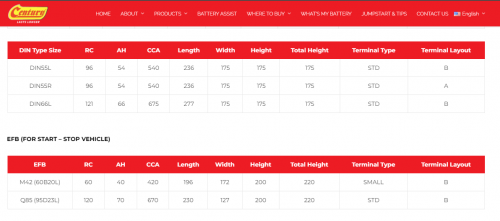QUOTE(p_otential_c @ Oct 27 2019, 05:30 PM)
Ah that clarifies things! Thanks
@outpace now can you tell me if they’re specced the same? Pretty sure Bosch costs way cheaper vs varta. If it’s the same factory why should I pay extra for brands sake.
Price is always subjective, depends on how much of premium that user willing to pay right? Starbucks might be sourcing cake from the local bakery but selling price aren't the same for sure.
Of course, these brands do have different specifications in play, hence the differences in price.
QUOTE(cent88 @ Oct 28 2019, 12:07 AM)
Other than CCA and AH, any other spec we shall take note as well? Like how much max current a battery can release in a sudden or short period of time.
What i noticed recently is my Yokohama Beta NS40 crank quicker than my FB HiDash NS40 and Amaron Hi Life NS60 in the same car.
Besides, the light dim the least when aircond compressor kick in and also engine accelerate smoother with Yokohama Beta.
Which make me feel that Yokohama Beta is Energizer AA battery and the other two are normal AA battery.
CCA isn't everything, especially when longevity is what we concern, if I'm not wrong, there are ways of making a lead acid battery to pump up higher CCA but sacrificing lifespan, the frame structure within, the acidic level of the electrolyte or something like that.
QUOTE(System Error Message @ Oct 30 2019, 01:58 PM)
wow 24 pages quite fast. I should throw some math here for your data and for other people.
A typical car battery from googling has around 45Ah (US standard), at 12V nominal. Taking the approximate, thats 12x45= 540Wh. Since its bad to let the battery discharge below 40%, that gives 3 out of 5 for our battery which equates to 324Wh. So if the idle power use of the car is 10W, that means it would have reached its low point in 32 hours. I looked up lead acid battery chemistry, they do like to be charged but dont like to be drained like a normal battery due to sulphation where the sulphur in the acid coats around the conductor and eventually blocks it off from conducting. The largest legal laptop battery you can bring on the plane is 100Wh, same applies to power banks and so on. A power bank of 20Ah (20000mAh) will have 3.7*20=74Wh.
Looking at this math, please please do not leave your lights on and minimise electrical usage of your car when the engine is off, and if you go off for a long time, please have another non lead acid battery charging your battery. If you drive everyday there is no need but if you go off for a week its something you should consider. Some ammeters can measure the electrical usage and perhaps something for you to consider testing to find out whether or not you need a charger if its over night or the minimum time you need to put a charger when you go off for long periods.
A couple of things i am trying to figure out, What is it that determines the capacity of the battery given the same sized lead acid battery for the same voltage?
I would also like to try experimenting, if its possible to create a NIMH supercap hybrid for below rm 2k for similar or better watt hours, which would mean 10 years of battery life, but if every 2 years you change your battery for rm 200, then that wouldnt be a saving, though the instant start from the supercaps could help start/stop features in cars.
How do you get the idle power use of the car, say for 12 hours, how to get the 10W?
That's why most of the sifus here who are able to stretch the lifespan of their normal flooded lead acid battery to many years are those who frequently charge their battery.
Let's not talk about those AGM sitting at the back of the car comfortably, cars like BMW, Audi, and BENZ. These AGMs are designed to be lasting very long time with better deep cycleability, but AGM also dig deeper from their owner's pocket, but I think it's worth to have them.
Look forward for your project bro NIMH supercap hybrid
there have been many trying for many years to get alternative for heavy and clumsy lead acid battery, but the fossil burning cars still not running away from the lead acid


 Apr 2 2019, 11:27 PM
Apr 2 2019, 11:27 PM

 Quote
Quote

 0.0189sec
0.0189sec
 0.40
0.40
 7 queries
7 queries
 GZIP Disabled
GZIP Disabled